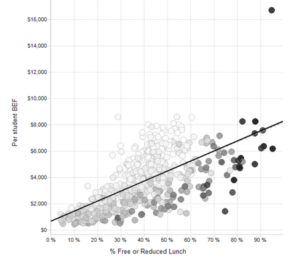Over a half century has passed since Brown v. Board of Education but educational segregation is still a reality, and Pennsylvania is a prime example of the problem. In the Keystone State, a Jim Crow policy assures that school districts with children of color are underfunded—not simply because they are poor and poorer communities have a lower tax base to adequately fund their schools, but because they are Black and Brown. Pennsylvania is a cautionary tale for the rest of the nation.
David Mosenkis, a data scientist, conducted research and delved into the root of the problem, as was reported in The Atlantic. Assessing the funding data or the 500 school districts in Pennsylvania, Mosenkis found that superficially, poor schools receive more funding than more wealthy districts, as one would expect, since more well-to-do communities require less state funding and can raise more revenue through local taxes. But digging deeper, Mosenkis learned that ultimately, school funding was based not on class or economics, but on race. The racial composition of the schools determine how much money they receive.

Black dots represent districts with no white students and white represents districts with 100 percent white students. (David Mosenkis)
“If you color code the districts based on their racial composition you see this very stark breakdown. At any given poverty level, districts that have a higher proportion of white students get substantially higher funding than districts that have more minority students,” Mosenkis told The Atlantic.
This means that the gaps in funding are determined by color, so that white schools, whether poor or not, receive more resources than their predominantly Black and Brown counterparts. The more color that is added to those predominantly white school districts, the lower their funding from the state.
“The ones that have a few more students of color get lower funding than the ones that are 100 percent or 95 percent white,” Mosenkis added.
Pennsylvania is one of the extreme cases nationwide, as one of the few states without a specific formula for disseminating aid to school districts, allowing for the role of partisanship to take over. It is said that Pennsylvania consists of Pittsburgh on the western end of the state and Philadelphia to the east, with Alabama in the middle. Both houses of the Pennsylvania General Assembly are Republican-controlled and represent the interests of the predominantly white “Alabama” midsection of the commonwealth, and show antipathy towards the cities where Black and Latino children predominate. It should be noted that in Pennsylvania, hate groups such as the Ku Klux Klan are active. Meanwhile, Tom Corbett, the former Tea Party governor, decimated the education budget, leading to massive school closures and teacher firings in districts such as Philadelphia, and the deaths of two students because there was no nurse on duty.
Tom Wolf, the new governor, wants to increase funding and a new school funding formula has been proposed, but with no state budget passed, has yet to be adopted. Moreover, Mosenkis warns that the new formula could potentially build off the existing biased funding base for each school system, and maintain some degree of racial bias.
Meanwhile, the nonprofit Education Law Center of Pennsylvania and the Public Interest Law Center of Philadelphia filed a suit in Pennsylvania Commonwealth Court in November 2014 on behalf of six school districts, seven parents, an association of 150 rural and small schools, and the Pennsylvania NAACP. The suit, William Penn SD et. al. v. Pa. Dept. of Education et. al., claims that lawmakers, state education officials and the Governor have failed to uphold the General Assembly’s constitutional obligation to “provide for the maintenance and support of a thorough and efficient system of public education to serve the needs of the Commonwealth.”
The complaint further alleges that the defendants adopted an irrational funding scheme that underfunds public school districts across Pennsylvania, and ignores the state’s own funding targets. The suit also claims that funding of public education in Pennsylvania “denies students equal educational opportunities by creating gross funding disparities between wealthy and poor school districts.”
Due to the low level of state spending, heavy reliance on local property taxes and an irrational, ad-hoc system of state spending, “per-pupil spending on education ranges from as little as $9,800 per student in school districts with low property values and incomes to more than $28,400 per student in districts with high property values and incomes.” As a result, according to the complaint, districts across the state are drastically underfunded, and unable to provide a basic quality education with qualified teachers and staff, appropriate class sizes, suitable facilities, updated textbooks and technology.
Although Pennsylvania is a most glaring example, it is by no means alone, as white flight, the abandonment of inner cities and chronic, systemic racial discrimination have perpetuated the segregation of public school education across the country.




